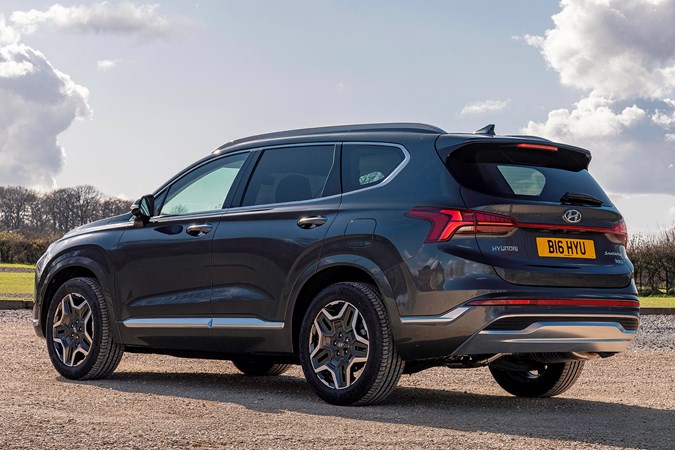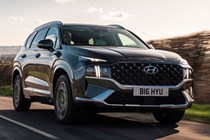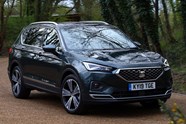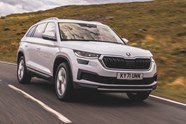
Hyundai Santa Fe PHEV review
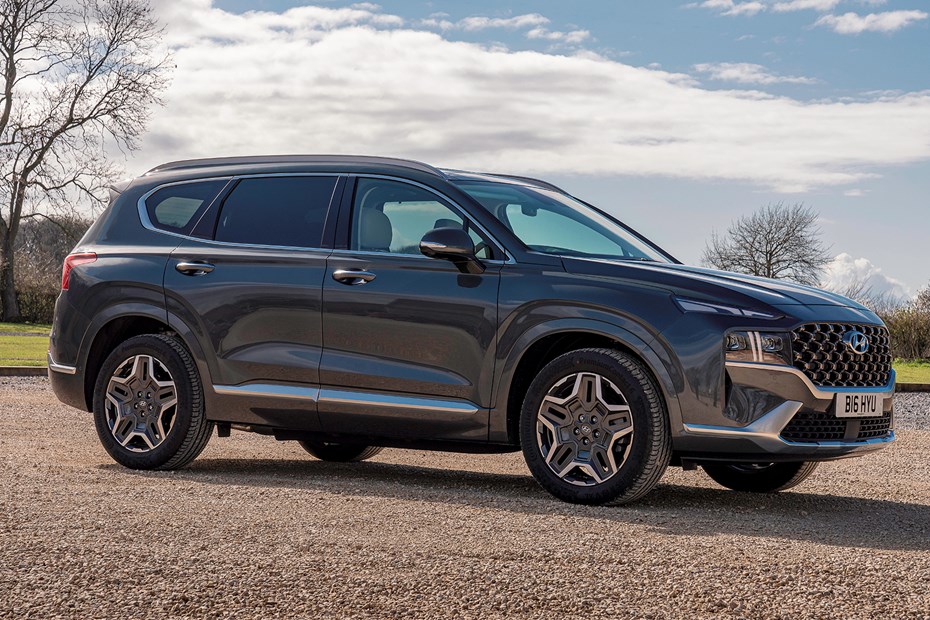
At a glance
| Price new | £48,385 - £58,635 |
|---|---|
| Used prices | £26,214 - £43,340 |
| Road tax cost | £590 |
| Insurance group | 26 - 27 |
Get an insurance quote with

|
|
| Fuel economy | Not tested to latest standards |
| View full specs for a specific version | |
Available fuel types
Alternative fuel
Pros & cons
- One of the few seven-seat plug-ins
- Spacious on all three rows
- Decent all-electric range
- Pricey to buy
- Not as luxurious as premium rivals
- Performance merely adequate
Hyundai Santa Fe PHEV rivals
Overview
While plug-in hybrids are a fantastic way to cut fuel and company car tax bills for many, their bulky battery packs often cause practicality issues. With them usually slung behind the rear seats, you’ll find boot capacity reduced whilst many seven seaters lose their third row. The Hyundai Santa Fe Plug-in Hybrid is not one of those cars.
That’s right, the Santa Fe combines a useful all-electric range and low CO2 emissions with proper seven seat practicality. It’s not the only SUV out there that manages that trick, the closely related Kia Sorento manages it as does the far pricier Volvo XC90 Recharge, but that’s about it. Unlike those SUVs, there’s no diesel option, just hybrid models.
That means the only gearbox option is a six-speed automatic, with the plug-in getting four-wheel drive as standard. You’re also limited in terms of trim levels, with only two well equipped models to pick from pushing the price towards that of premium-badged, albeit five-seat, rivals such as the BMW X3 30e and Land Rover Discovery Sport P300e.
What’s it like inside?
All versions of the Santa Fe Plug-in Hybrid come with fully electric heated front seats including adjustable lumbar support, while top-spec Ultimate versions add front seat ventilation and a memory function for the driver’s seat. That means all shapes and sizes will be able to get comfortable with ease while space is plentiful.
Regardless of version, the Santa Fe comes with a 10.25-inch touchscreen infotainment system with sat nav, Apple CarPlay and Android Auto. The system is mounted nice and high on the dash so you don’t have too far from the road to use it, while the graphics are sharp and system responsive. Only a few small icons let it down.
The mass of buttons on the centre console take some getting used to, but are certainly preferable to the touch sensitive icons found on many cars and SUVs these days. Quality is good with a feeling of solidity, but you won’t find a luxury feel that makes premium-badged rivals such as the Audi Q5 and Land Rover Discovery Sport so popular.
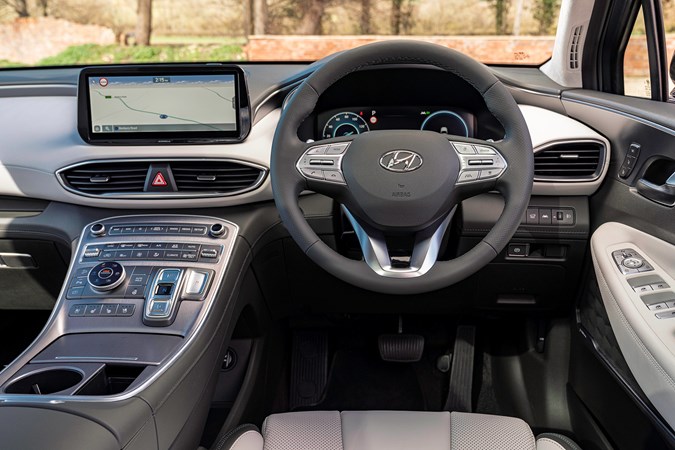
Practicality
Forward visibility is good, helped by a lofty driving position, although the rear pillars are rather chunky. That won’t be too much of an issue when parking as all versions come with a rear camera plus front and rear parking sensors. Jump to Ultimate trim, and the camera is upgraded to a surround view item that’ll help prevent your shiny new alloys getting kerbed.
However, we suspect it’s rear space that’ll be of most interest to Santa Fe buyers. Even six-footers will be happy in the middle row, especially with the bench slid all the way back, while they’ll fit in the easily erected third row for reasonably short trips. Indeed, the Santa Fe (and its Kia Sorento cousin) are better here than many rivals including the Land Rover Discovery Sport, SEAT Tarraco and Volkswagen Tiguan Allspace. For the most space, we’d avoid Ultimate trim as the panoramic roof this brings eats into head room especially for rear seat passengers.
Boot space with all seven seats in place isn’t amazing, but there’s space for a few bags of shopping. In five seat mode the boot is huge, whilst fold all the rear seats down and you’ll find a handily flat load area that could challenge some vans for capacity. Impressively, the only reduction in boot capacity compared to the Hybrid is below the floor which isn’t raised unlike some PHEVs. It does mean you can’t put the load cover under the boot floor, though.
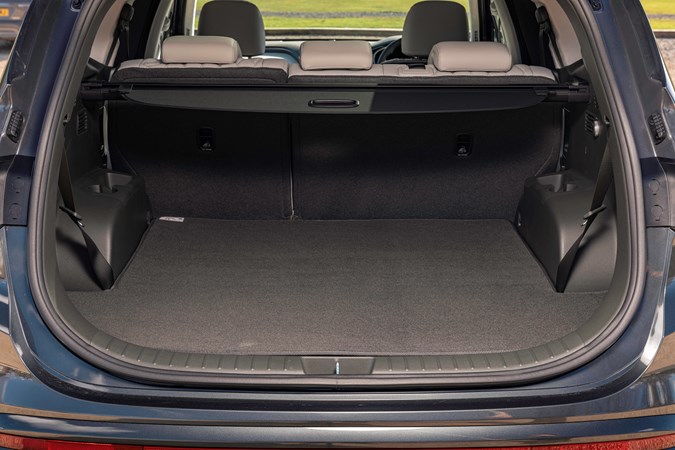
What’s it like to drive?
Like the regular Santa Fe Hybrid, the Plug-in gets a 1.6-litre turbocharged petrol engine under its bonnet with 180hp. However, the Plug-in gets a much bigger battery and a more powerful electric motor, taking the total output to 265hp. This is channelled to all four-wheels via a six-speed automatic gearbox, enabling a 0-62mph time of 8.8 seconds making it the quickest version in the range. Even so, most PHEV rivals are swifter still.
Performance in electric mode is just about adequate during normal flowing traffic, but it doesn’t take too hard a squeeze of the accelerator pedal to wake up the petrol engine. That’s no surprise as the electric motor only has 91hp to call upon, not a lot for a hefty seven-seat SUV. Unlike some rivals, the engine joins in smoothly and without much in the way of hesitation, staying quiet unless really pushed. This reveals a slightly gravelly tone that you won’t hear too often under normal driving.
At speed the Santa Fe Plug-in is pretty comfortable, although potholes and pimples do generate a bit of thudding and thumping, not helped by standard 19-inch alloy wheels. This is especially pronounced around town, where the Santa Fe can fidget frustratingly. This slightly stiff edge means body roll is present, but not too pronounced while precise steering makes it easy to place on the road.
It’s by no means fun, but very few hefty SUVs are. What’s important is that there’s plenty of grip and no nasty vices if you do go barrelling into a corner to quickly. Standard four-wheel drive will prove handy should you find yourself in a waterlogged grass carpark, but don’t expect Land Rover like off road ability. If you’re wondering about towing, the maximum braked capacity is 1,350kg, 300 less than the regular Hybrid.
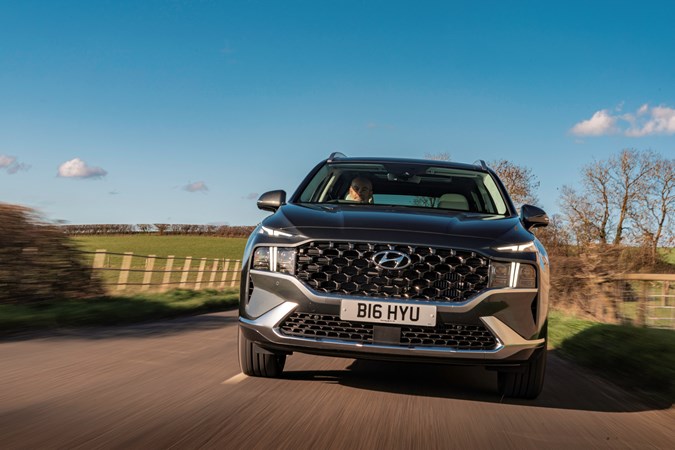
What models and trims are available?
Like all Santa Fes, the Plug-in only comes in two well-equipped trim levels. We’d argue entry-level Premium has all the toys you could possibly need including leather seats, dual-zone climate control, LED headlights, 19-inch alloy wheels, self levelling suspension keyless entry and start, automatic emergency braking and adaptive cruise control.
Top Ultimate trim adds a panoramic sunroof, smart parking assist, a fully digital driver’s display, a head up display and blind spot monitoring for not much more in the grand scheme of things. However, this pushes the price even closer to premium-badged rivals.
What else should I know?
Hyundai claims the electric only range is 36 miles per charge, although in most scenarios you can knock around 10 miles off that. You’d need to be tootling around town for the most part to get close to the claimed range. With both power sources working together economy is pretty decent, though; we saw 48.5mpg on our test route. What you get will depend entirely on how often you charge and how long your journey is, though.
That claimed electric only range means WLTP CO2 emissions of 37g/km which puts it in one of the lower BIK tax bands. There are only a handful of PHEV SUVs that are in a lower band, including the far pricier and five-seat only BMW X5 45e and Mercedes GLE 350de.
Read on for our Hyundai Santa Fe PHEV verdict…
